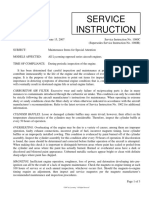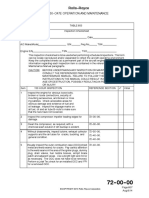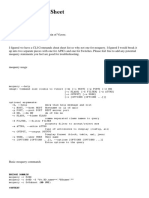Dhc-1 Maintenance Schedule
Dhc-1 Maintenance Schedule
Uploaded by
JoeQuinn23Copyright:
Available Formats
Dhc-1 Maintenance Schedule
Dhc-1 Maintenance Schedule
Uploaded by
JoeQuinn23Copyright
Available Formats
Share this document
Did you find this document useful?
Is this content inappropriate?
Copyright:
Available Formats
Dhc-1 Maintenance Schedule
Dhc-1 Maintenance Schedule
Uploaded by
JoeQuinn23Copyright:
Available Formats
MAINTENANCE SCHEDULE As any maintenance schedule is designed to keep the engine in a satisfactory and efficient mechanical condition, its
composition is largely determined by the local conditions under which the aircraft is housed and operated, by the duration of the flight, and by the power at which the aircraft is generally flown. The schedule should comprise routine attentions and periodical examinations to check adjustments, and to ascertain the progress of wear and tear and of deterioration, this latter being particularly important if the engine is flown only at intervals. No schedule compiled without reference to each operator's specific conditions can be more than an estimate of the engine's requirements, and to obtain the maximum reliability and serviceability at the minimum cost it must be modified and adjusted as experience dictates. The following detail of routine checks and inspections constitutes a maintenance schedule arranged in multiples of fifty hours to meet the first requirements, and to serve as a basis from which, for each particular case, the most efficient schedule can be compiled.
Pre-flight inspection Examine the pilot's report or running log for the previous day and correct any faults noted. Fill the lubricating oil tank with oil to the specification given in the Leading Particulars. Check the installation for blowing or leaky joints and rectify or renew as necessary. 10 Hours after installation Turn the handle of the "Auto-Klean" pressure filter. Inspect the unions and pipe lines of the fuel, priming and lubricating systems for damage and leaks, paying particular attention to the suction side of the oil pressure pump. Check that vent and breather pipes are unobstructed. Check all cylinder heads nuts for tightness. All nuts should be tightened equally. The rocker bracket bolts should also be checked for tightness, and the tappet clearances checked and if necessary adjusted, after all tightening of the nuts and bolts has been completed. Check that the fixed-pitch propeller* is tight on its shaft-repeat after a further ten hours if any adjustment is found necessary. Every 50 hours Clean down the engine. Examine the pilot's report or running log and correct any faults noted. Examine the contact breaker points and check the contact breaker point gaps. Ensure that all L.T. and H.T. connections to the magneto are secure. Examine and clean the suction and scavenge filters, and turn the handle of the "Auto-Klean" pressure filter. After refitting the oil filters, prime the lubricating system if necessary.
Examine and clean the fuel filter in each pump. Examine all joints and unions for leakage of oil, fuel, gas, etc. Remake any joint which leaks, renewing the gasket or joint washer if necessary. Inspect the exhaust manifold or stub pipes for signs of burning or cracking. Lubricate all joints, cables and bearings in the engine control linkwork, including the spindle on the flame trap valve, and examine for serviceability and operation. Inspect the fixed-pitch propeller* for signs of looseness or damage. Every 100 hours Repeat the 50 hour inspection and in addition Check all cylinder head nuts for tightness. One nut should not be tightened more than another. Remove the valve gear covers and examine the valve springs for serviceability, without removing the latter. Check the rocker bracket bolts for tightness, and check the tappet clearances and adjust if necessary. Clean the rocker covers and refill each with fresh oil to the correct specification (see Leading Particulars) to the level of the collar on the vent pipe (see Fig. 1). Remove all eight sparking plugs and clean, test and reset gap. Drain the oil tank and refill with fresh oil to the correct specification (see Leading Particulars). Check all exhaust and induction manifold nuts for tightness. Check the security of all accessories, the carburetor and fuel pumps, and also their respective wiring or pipelines. Examine the engine bearer arms for security, and ensure that the rubber mounting blocks are in good condition. Remove the distributor, and clean and check the condition of the H.T. pick-up brush (see chapter XV).
Remove the contact breakers, recondition as necessary, and lubricate as detailed in chapter XV. Lubricate the impulse starter with the grade of oil specified in chapter XV. Every 300 hours The foregoing inspections should be repeated after each succeeding 50 and 100 hour period of running, but at each 300 hours the following inspections should be carried out in addition to the normal 100 hour inspection. Remove and clean the "Auto-Klean" pressure filter and clean out the sediment from the filter body. Inspect and, if necessary, clean out the flame trap. Examine the magneto flexible couplings for deterioration and oil soakage.
Clean the magneto H.T. pick-up slip rings and the flange mouldings (see chapter XV). Examine the insulation of the L.T. cables. The following additional inspections apply to Major 10 Mk. I engines only. Remove the propeller hub and inspect, with the aid of a magnifying glass, the area of the crankshaft around the keyway and towards the thrust race retaining nut thread for signs of cracks. Examine the propeller hub key for 'stepping' and check that the key has no excess movement in the keyway. UNTIL THE ENGINE OVERHAUL period specified in the Leading Particulars is reached, the 50-100-300 hour inspection cycle should be repeated as laid down in the foregoing schedule.
* The manually variable-pitch propeller should be inspected periodically in accordance with the instructions in the relevant handbook. When the lubricating system has been drained, or if after refitting the oil filters the oil pressure fails to build up immediately the engine is started, the lubricating system should be primed as described on page 2
You might also like
- Wärtsilä 32 Engine Instruction Manual 04. Maintenance ScheduleDocument12 pagesWärtsilä 32 Engine Instruction Manual 04. Maintenance ScheduleSalman Kapoor100% (2)
- CLG418 Operation &maintainance ManualDocument66 pagesCLG418 Operation &maintainance ManualLYCANTROPOFAGO89% (9)
- Diesel Engine Maintenance ChecklistDocument6 pagesDiesel Engine Maintenance Checklistjohnnybe5183% (6)
- Inspection Checklist For LYCODocument22 pagesInspection Checklist For LYCODavid DoughtyNo ratings yet
- Syllabus Grad SCH Public Fiscal AdministrationDocument3 pagesSyllabus Grad SCH Public Fiscal AdministrationANGELITA U. ALONZO100% (10)
- CLG418 Operation Maintainance Manual 1Document66 pagesCLG418 Operation Maintainance Manual 1ruslan futkaradzeNo ratings yet
- MotorDocument4 pagesMotorjoaofelippejsaNo ratings yet
- Mooney M20 100 Hour Annual 2007Document2 pagesMooney M20 100 Hour Annual 2007flyokie100% (1)
- Range Rover Maintenance ManualDocument34 pagesRange Rover Maintenance Manualsleepyninjitsu100% (1)
- V40232 Clark C270 Torque ConverterDocument44 pagesV40232 Clark C270 Torque ConverterRemHenry100% (6)
- Manitowoc 4600 S4 Lubrication Guide PDFDocument40 pagesManitowoc 4600 S4 Lubrication Guide PDFnamduong368100% (1)
- 250 - C28 Series Operation and Maintenance: Rolls - RoyceDocument6 pages250 - C28 Series Operation and Maintenance: Rolls - RoyceturboshaftNo ratings yet
- Preventive Maintanance Interval 10 Whell Loader SDLGDocument40 pagesPreventive Maintanance Interval 10 Whell Loader SDLGAdy Prasetyo100% (2)
- Guias de Inspeccion Cheyenne IIDocument23 pagesGuias de Inspeccion Cheyenne IIesedgar100% (1)
- M250 - C20R Series Operation and MaintenanceDocument8 pagesM250 - C20R Series Operation and MaintenanceturboshaftNo ratings yet
- Unit Ii Inspection of Piston EngineDocument45 pagesUnit Ii Inspection of Piston Engineraj6062No ratings yet
- C47B OmmDocument12 pagesC47B OmmturboshaftNo ratings yet
- Compressor ChecklistDocument4 pagesCompressor ChecklistEber.CV100% (1)
- Compressor ChecklistDocument5 pagesCompressor ChecklistJuanPabloAlvarez100% (1)
- Image Server HandlerDocument12 pagesImage Server Handlerbobcat1810No ratings yet
- Oh LolDocument5 pagesOh Lolrhomel hamoyNo ratings yet
- RR250 - C40B OmmDocument13 pagesRR250 - C40B OmmturboshaftNo ratings yet
- Skt-Maintenance of Electro-Mechanicl Equipment of SHPDocument51 pagesSkt-Maintenance of Electro-Mechanicl Equipment of SHPsktyagi_iitr6102No ratings yet
- RR250 - C30 OmmDocument16 pagesRR250 - C30 Ommturboshaft100% (1)
- Weekly Maintenance Checks: Ensure Daily Checklist Has Been Completed and Signed Off For This WeekDocument8 pagesWeekly Maintenance Checks: Ensure Daily Checklist Has Been Completed and Signed Off For This WeekfcfernandoNo ratings yet
- Hoisting and Mounting The Engine For Installation1Document5 pagesHoisting and Mounting The Engine For Installation1SantiagoDaFornoAmorochoNo ratings yet
- Aero Engine Maintenance and Repair Unit 2Document40 pagesAero Engine Maintenance and Repair Unit 2Parvathi GanesanNo ratings yet
- Maintenance and Repair of Fuel Suppply, Lubrication and Cooling System Fuel Pump TestingDocument12 pagesMaintenance and Repair of Fuel Suppply, Lubrication and Cooling System Fuel Pump TestingAdarsh AnilNo ratings yet
- Zabatt Compressor MaintenanceDocument5 pagesZabatt Compressor MaintenanceMuhammad Arslaan100% (1)
- AMWDocument14 pagesAMWSudeesh BabuNo ratings yet
- M250-B17 O+mmDocument14 pagesM250-B17 O+mmturboshaftNo ratings yet
- D6R Maintenance Interval ScheduleDocument12 pagesD6R Maintenance Interval Schedulepedro sanchezNo ratings yet
- Er-8 2 2Document4 pagesEr-8 2 2Carlos MantillaNo ratings yet
- Maintenance, Make-Ready and Safety Checklist For Little Beaver Mechanical Earth DrillsDocument1 pageMaintenance, Make-Ready and Safety Checklist For Little Beaver Mechanical Earth Drillsyuganshu_soniNo ratings yet
- Instruction - Flushing Gas Turbine Lubricant Oil SystemDocument5 pagesInstruction - Flushing Gas Turbine Lubricant Oil SystemRicky Hendra Silalahi67% (3)
- Chap 49Document3 pagesChap 49DeepakNo ratings yet
- Hookloader-Manual HarshDocument35 pagesHookloader-Manual HarshMiks EzersNo ratings yet
- TB Maintenance ConceptDocument16 pagesTB Maintenance ConceptNur Farahatan100% (1)
- Halliburton: HWO Power Pack PM Meter Shop Date H03A Suggested Interval: 60 DAYSDocument4 pagesHalliburton: HWO Power Pack PM Meter Shop Date H03A Suggested Interval: 60 DAYSKhalfan Al HabsiNo ratings yet
- Maintenance Préventive Du SULLAIR 260Document17 pagesMaintenance Préventive Du SULLAIR 260MMF PLUSNo ratings yet
- Engine Maintenance For Gas Turbine AssignmentDocument7 pagesEngine Maintenance For Gas Turbine AssignmentMuhamad AimanNo ratings yet
- Vaš Kontrolni Popis Za Preventivno OdržavanjeDocument6 pagesVaš Kontrolni Popis Za Preventivno Održavanjemedija123No ratings yet
- ChecklistDocument3 pagesChecklistAndy Noven KrisdiantoNo ratings yet
- SID97-3C ADJUSTMENT of Continental Fuel InjectionDocument41 pagesSID97-3C ADJUSTMENT of Continental Fuel InjectionTito Teixeira100% (1)
- ChecklistDocument2 pagesChecklistdassayevNo ratings yet
- Motors Preventive Mentinance SheetDocument5 pagesMotors Preventive Mentinance SheetEngr. Talat KhanNo ratings yet
- General Knowledge Overhauling The CompressorDocument2 pagesGeneral Knowledge Overhauling The CompressorAfhnan TemiziNo ratings yet
- Inspection and Overhaul For Reciprocating CompressorDocument79 pagesInspection and Overhaul For Reciprocating CompressorSalik Ali SyedNo ratings yet
- Hydro Power MaintenanceDocument26 pagesHydro Power Maintenancetrxrhcp50% (4)
- Unit Iv Classification of Jet Engine ComponentsDocument81 pagesUnit Iv Classification of Jet Engine Componentsraj6062No ratings yet
- PM Service ChecksheetDocument2 pagesPM Service Checksheetnuetron846No ratings yet
- Centrifugal Pump Checklist 2023Document7 pagesCentrifugal Pump Checklist 2023Caesar MutizeNo ratings yet
- D6TMaintenance Interval ScheduleDocument12 pagesD6TMaintenance Interval Schedulepedro sanchezNo ratings yet
- Maintenance Items For Special Attention SI1080C PDFDocument3 pagesMaintenance Items For Special Attention SI1080C PDFDavid OrtizNo ratings yet
- Yancheng Control Panel For Choke Manifold - Operation Manual PDFDocument27 pagesYancheng Control Panel For Choke Manifold - Operation Manual PDFDaniel MedinaNo ratings yet
- C47E OMM Inspection ChecksheetsDocument13 pagesC47E OMM Inspection ChecksheetsturboshaftNo ratings yet
- The Book of the Singer Junior - Written by an Owner-Driver for Owners and Prospective Owners of the Car - Including the 1931 SupplementFrom EverandThe Book of the Singer Junior - Written by an Owner-Driver for Owners and Prospective Owners of the Car - Including the 1931 SupplementNo ratings yet
- Plymouth and Chrysler-built cars Complete Owner's Handbook of Repair and MaintenanceFrom EverandPlymouth and Chrysler-built cars Complete Owner's Handbook of Repair and MaintenanceNo ratings yet
- Storage TanksDocument97 pagesStorage Tanksaa6333900100% (1)
- TSPSC Group 1Document2 pagesTSPSC Group 1narmadasriramadasuNo ratings yet
- (P) Work, Power & Energy ExerciseDocument35 pages(P) Work, Power & Energy ExerciseSocial Credits Positive Million AspirantNo ratings yet
- Manual Armoblock ABDocument24 pagesManual Armoblock ABJermy Abraham CarrascoNo ratings yet
- Laboratory and Plant Investigations On Decomposition Products of Morpholine in The Secondary System of French PWRDocument8 pagesLaboratory and Plant Investigations On Decomposition Products of Morpholine in The Secondary System of French PWRDmytroNo ratings yet
- Biological ModelDocument10 pagesBiological ModelHoney-Zeth TalaveraNo ratings yet
- Maths Homework Booklet Year 1Document4 pagesMaths Homework Booklet Year 1axnybeapd100% (1)
- Gea Bock 96023 GBDocument64 pagesGea Bock 96023 GBDejan C CiepecintakomickNo ratings yet
- Moquery Cheat Sheet: Bridge DomainDocument6 pagesMoquery Cheat Sheet: Bridge Domainravi kantNo ratings yet
- Spss 1Document122 pagesSpss 1Azka Faradiba Anjani HulayyaNo ratings yet
- Bio Concepts PresentationDocument28 pagesBio Concepts PresentationDiah K. AyuNo ratings yet
- 11 86 Me DTS 00008Document3 pages11 86 Me DTS 00008Erdal CanNo ratings yet
- Ebook Future Proofing Internal AuditDocument22 pagesEbook Future Proofing Internal Auditgoyosito100% (1)
- 2023 GMN NV Arr Manchon TibaoDocument4 pages2023 GMN NV Arr Manchon Tibaokader.guemaounNo ratings yet
- Silao Entrepreneurship - Exercise Workbook For StudentDocument57 pagesSilao Entrepreneurship - Exercise Workbook For StudentdwyquishNo ratings yet
- General Studies New SyllabusDocument4 pagesGeneral Studies New SyllabusmykhaulujjhjNo ratings yet
- Murdo Coyote, March 28, 2013Document10 pagesMurdo Coyote, March 28, 2013surfnewmediaNo ratings yet
- AppCenter 2.0 Build 1173 Release NotesDocument13 pagesAppCenter 2.0 Build 1173 Release NotesHatem ElbeziNo ratings yet
- Genet Feyisa Research Proposal To Be SubmittedDocument19 pagesGenet Feyisa Research Proposal To Be SubmittedEftiyom MuletaNo ratings yet
- Binomial ExpansionsDocument5 pagesBinomial ExpansionsShafiqueDeshongNo ratings yet
- GD&T 1Document69 pagesGD&T 1JayanthiANo ratings yet
- Middle East Chronology - 1971-02-16 - 1971-05-15Document18 pagesMiddle East Chronology - 1971-02-16 - 1971-05-15rinaldofrancescaNo ratings yet
- E3-3 (Based On AICPA) General Problems: Balance Sheet AccountsDocument10 pagesE3-3 (Based On AICPA) General Problems: Balance Sheet AccountsSintia Marada Hutagalung50% (2)
- Sonnenbatterie b10 - Installation Manual - 1000241 Au557enDocument100 pagesSonnenbatterie b10 - Installation Manual - 1000241 Au557enyahousefNo ratings yet
- Epri-Pra Module 1Document332 pagesEpri-Pra Module 1Fazer ProjeNo ratings yet
- Haryana Mains 2022 - Paper 1Document2 pagesHaryana Mains 2022 - Paper 1Sukriti tripathiNo ratings yet
- Seamless, Welded, and Heavily Cold Worked Austenitic Stainless Steel PipesDocument12 pagesSeamless, Welded, and Heavily Cold Worked Austenitic Stainless Steel PipesHugo IgrejaNo ratings yet
- NAC20-33K-DT User ManualDocument21 pagesNAC20-33K-DT User ManualWaldemar Alvares RezendeNo ratings yet
- (Import) Understanding JCOP - Memory Dump - Re-Ws - PLDocument1 page(Import) Understanding JCOP - Memory Dump - Re-Ws - PLJack DanielsNo ratings yet

























































































